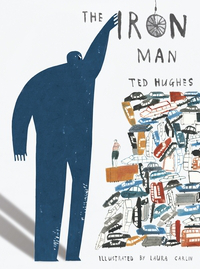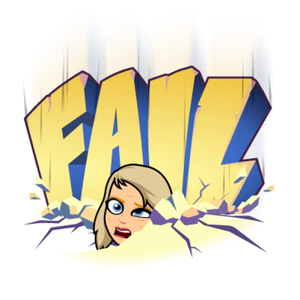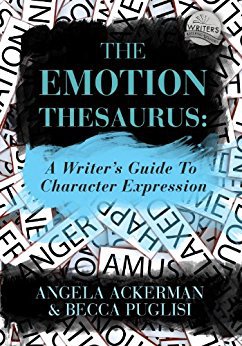This blog post comes from Kate, a community librarian based in the east of the city.
I thought about organising my recommendations for illustrated books by age group, or category but in the end I decided against it. “Picture Books” are still often regarded as the territory of small children, but I hope this selection proves that is not the case.
 The Iron Man by Ted Hughes, illustrated by Laura Carlin
The Iron Man by Ted Hughes, illustrated by Laura Carlin
This is a classic modern fairy tale of a boy who befriends a dangerous, but misunderstood, metal guzzling robot who goes on to save the world. In this edition Laura Carlin’s stunning illustrations evoke a real sense of drama. The book includes gatefold pages and peep holes giving a physical dimension to sections of building tension as well as the huge scale of the story and its monsters.
The striking images and simple drama of Hughes’ text are so successful at creating the world of The Iron Man that I find myself getting lost between the pages of this book over and over again. The message of love and peace is universal, applicable across age groups and decades.
 Sally Heathcote, Suffragette– by Mary M. Talbot artist- Kate Charlesworth
Sally Heathcote, Suffragette– by Mary M. Talbot artist- Kate Charlesworth
Telling the story of Sally Heathcote, a character of a maid working for Emmeline Pankhurst in turn of the century Manchester, the graphic novel offers another way into the world of the suffragettes. As a reader, you journey through time with Sally, watching the movement progress and the main character become more informed, better educated and increasingly politically involved. Using the personal viewpoint of Sally gives already shocking elements of the story, such as the force feeding of political prisoners, even more intensity and brings home both the horror of the event and the strength of the women who went through it.
The format of the graphic novel drew me in to the narrative, immersing me in the emotional and political turmoil experienced by activists whilst also feeding me information about the struggle through the inclusion of headline events and important dates. The artist uses gentle tones throughout, but with shocks of colour, including Sally’s red hair that show the passion and strength of the women. The purple, green and white of the suffragette movement are also prominent and the pictures deliver a lasting visual impression of the determination of the women involved. Whether as an introduction to the subject, or as an emotive read for those already familiar with the facts, I think this powerful book is well worth a read.
 Something About a Bear written and illustrated by Jackie Morris
Something About a Bear written and illustrated by Jackie Morris
On a recent trip to our suppliers to purchase children’s non-fiction books, I couldn’t tear myself away from the gaze of the beautiful brown bear gazing out from the cover of this book. Every double page spread is filled with an immense and detailed painting of bears and poetic descriptions of the species and how they live. Despite undeniably offering an education on bears, this book is far from being a typical information book. I challenge you to walk past this book on a shelf without picking it up and burying yourself in its pages.
 A Child of Books by Oliver Jeffers, illustrated by Oliver Jeffers and Sam Winston
A Child of Books by Oliver Jeffers, illustrated by Oliver Jeffers and Sam Winston
Anyone who knows much about my reading habits will not be surprised to see a book by Oliver Jeffers on this list. They may be surprised to see only one and I must admit it was a hard choice. If you are not familiar with his work, get out there and explore it!
The plot follows a little girl leading a boy on an adventure of the imagination through the varied worlds of literature but A Child of Books if much more than a story- it’s a mantra for reading, a reminder about the importance and magic of the imagination. Would it go too far to say that this should be compulsory reading for all children, parents, educators, librarians, those who love books and those who don’t…?
Sam Winston and Oliver Jeffers collaborated on the illustrations combining Jeffers’ stylish line drawings and Winston’s typography to create a world truly made of books which the characters explore. Winston has used extracts from children’s classics from appropriate genres to match each setting. The illustrations in this book not only strengthen the story but add a historical, literary dimension encouraging readers to explore literature beyond the picture book world.
 A Monster Calls written by Patrick Ness illustrated by Jim Kay
A Monster Calls written by Patrick Ness illustrated by Jim Kay
This is the heart-breaking story of a real life nightmare as teenaged Connor struggles with the impending loss of his mother to cancer. Visited nightly by a monster, telling dark and twisted tales, Connor comes face to face with his situation and learns a difficult and upsetting truth.
There are many editions of this beautiful story available, and it has also been made into an amazing film, but this illustrated version, with its dark, tangled illustrations is particularly haunting. Kay’s pictures evoke the deep sense of oncoming doom felt by Connor. If you can bear the heart-break of the inevitable ending, choose to read this illustrated version of the book.
 This is Not my Hat written and illustrated by Jon Klassen
This is Not my Hat written and illustrated by Jon Klassen
My favourite of a trilogy of picture books by Jon Klassen featuring hats, conflict and controversy, This is Not my Hat tells the story of a small but plucky fish who has stolen the hat of a much larger fish. Klassen’s bold pictures give a sense of dramatic irony as the text relates the little fish’s thoughts and the illustrations show us what’s really going on! I highly recommend all three titles, the other two being I Want my Hat Back and We Found a hat. Fabulous to share with children (those who can’t or won’t read will certainly want to “read” the pictures) or to take pleasure in on your own (I bought a copy for my Dad for father’s day and he loves it).
 Shackleton’s Journey written and illustrated by William Grill
Shackleton’s Journey written and illustrated by William Grill
Telling the epic survival story of Ernest Shackleton and the crew of The Endeavour, there is something about the size of this book along with the glorious double page spreads, which give the reader a sense of the scale of the adventure.
Some of my favourite pages include those which feature an illustration of each member of the crew along with their names and roles on board and the page which pictorially lists all of the equipment and supplies taken on the expedition. As the journey progresses, you are treated to dramatic seascapes in tones of blue, black and white. The text may seem minimal in comparison to the pictures, but it tells the true story in a narrative style that entertains and informs. This is a luxurious non-fiction book that can be enjoyed by adults and children alike.
 The Thrilling Adventures of Lovelace and Babbage: the (mostly) true story of the first computer written and illustrated by Sydney Padua
The Thrilling Adventures of Lovelace and Babbage: the (mostly) true story of the first computer written and illustrated by Sydney Padua
This graphic novel takes place in a fictional history where Charles Babbage completed the building of his Analytical Engine and teams up with Ada Lovelace for a series of adventures. The pair bump into various historical figures including George Eliot and Queen Victoria in comical but historically relevant scenarios.
Bold, steampunk inspired illustrations successfully engage the reader into wanting to know more about the topic and the copious footnotes, endnotes and appendixes comply, straightening out the facts from the fiction.
This is one for computing enthusiasts, comic lovers and the uninitiated alike!
- More





